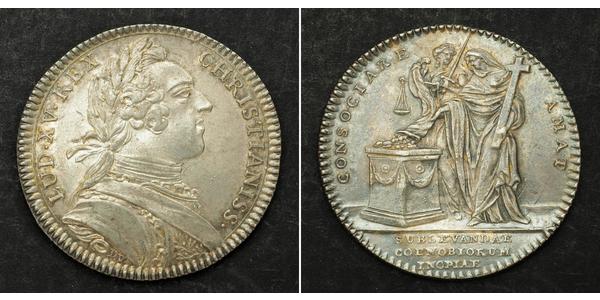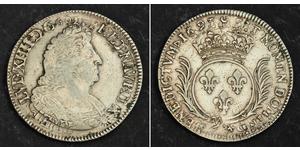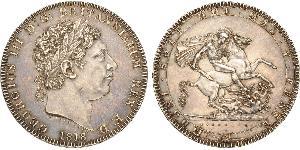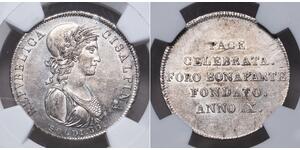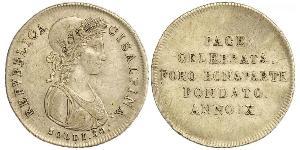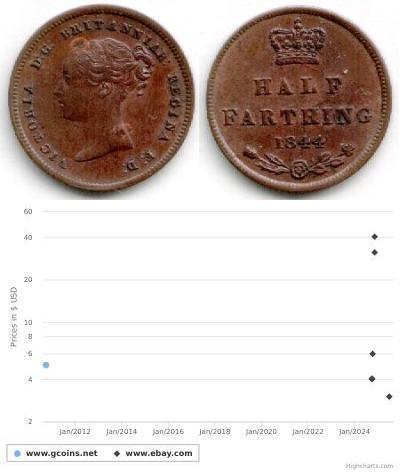(sold for $41.0)
1753, Royal France, Louis XV. Silver "Assembly of the Clergy" Jetton/Token Coin.
Mint Year: 1735 Mint Place: Paris Medallist: Du Vivier (D.V.) Denomination: Jetton (Medallic Coin) - Assembly of the Clergy in 1735 Condition: Light dark oxidation in reverse, otherwise a nice XF-AU with some luster! Diameter: 30mm Material: Silver Weight: 9.7gm
Obverse: Draped and armored bust of Louis XV right with medallist´s signature (D.V. for Du Vivier) below. Legend: LUD . XV . REX-CHRISTIANISS . Reverse: Two togate allegoric figures of Faith/Religion (holding long cross) and Justice (with scales, and sword) pouring coins from a horn of plenty (coruncopia) an a wreathed base. Legend: CONSOCIARE - AMAT Exergue: SUBLEVANDAE COENOBIORUM INOPIAE.
Jetons were widely used by government institutions such as state treasuries, revenue services and the bureos, stewardship courts or councils that supervised the royal family´s finances and internal affairs. The production of jetons for such institutions was standardised and regulated. WIn time, they ceased to be used for accounting purposes and became mere instruments of political propaganda.
The assembly of the French clergy (assemblée du clergé de France) was in its origins a representative meeting of the Catholic clergy of France, held every five years, for the purpose of apportioning the financial burdens laid upon the clergyof the French Catholic Church by the kings of France. Meeting from 1560 to 1789, the Assemblies ensured to the clergy an autonomous financial administration, by which they defended themselves against taxation.
During the Middle Ages the Crusades were the occasions of frequent levies upon ecclesiastical possessions. The Dime Saladine (Saladin Tithe) was inaugurated when Philip II Augustus (1180–1223) united his forces with those of Richard of England to deliver Jerusalem from Saladin. At a later period the contributions of the clergy were increased, and during the reign of Louis IX (1235–70) we find record of thirteen subsidies within twenty-eight years.
Francis I of France (1515–48) made incessant calls on the ecclesiastical treasury. The religious wars of the sixteenth century furnished the French kings with pretexts for fresh demands upon the Church. In 1560, the clergy held a convention at Poissy to consider matters of Church-reform, an occasion made famous by the controversy (Colloque de Poissy) between the Catholic bishops and the Protestant ministers, in which the chief orators were the Cardinal of Lorraine and Theodore Beza. At this assembly the Clergy bound themselves by a contract made in the name of the whole clerical body to pay the king 1,600,000 livres annually for a period of six years; certain estates and taxes that had been pledged to the Hôtel de Ville of Paris for a (yearly) rente, or revenue, of 6,300,000 livres. In other words, the clergy bound themselves to redeem for the king in ten years a capital of 7,560,000 livres. The French monarchs, instead of settling their debts, made fresh loans based on this revenue, paid by the Church, as if it were to be something permanent. After lengthy discussions, the clergy assembled at Melun (1579–80) consented to renew the contract for ten years, a measure destined to be repeated every decade until the French Revolution. The "assemblies of the Clergy" were now an established institution. In this way the Church of France obtained the right of freely meeting and of free speech just when the meetings of the Estates-General (États généraux) were to be discontinued, and the voice of the nation was to be hushed for a period of 200 years.
At a very early date, these assemblies adopted the form of organization which they were to preserve until the French Revolution. The election of deputies forming the body was arranged according to ecclesiastical provinces. It was decided in 1619 that each province should send four deputies (two bishops and two priests) to the assemblées de contrat held every ten years, and two to the assemblées des comptes which met once during the interval of ten years. Under this arrangement an assembly was convened every five years. There were two steps in the election of deputies. First, at the diocesan assembly were convened all holders of benefices, a plurality of whose votes elected two delegates. These then proceeded to the metropolitan see, and under the presidency of the metropolitan elected the provincial deputies. Theoretically, parish priests (curés) might be chosen, but as a matter of fact, by reason of their social station, inferior to that of abbés and canons, they seldom had seats in the assemblies. The rank of subdeacon suffices for election; the Abbé Legendre relates in his memoirs as a contemporary incident that one of these young legislators, after an escapade, was soundly flogged by his perceptor who had accompanied him to Paris. The assemblies at all times reserved to themselves the right of deciding upon the validity of procurators and the authority of deputies. They wished also to reserve the right of electing their own president, whom they always chose from among the bishops. However, to conciliate rivalries, several were usually nominated for the presidency, only one of whom exercised that function. Under a strong government, withal, and despite the resolution to maintain their right of election, the Assemblies were unlikely to choose a person not in favour at court. We know that during the reign of Louis XIV Harlay de Champvallon, Archbishop of Paris, was several times president. Finally, Saint-Simon tells us the royal displeasure deprived him of his influence with the Clergy, and even shortened his life. The offices of secretary and "promotor", being looked on by the bishops as somewhat inferior, were assigned to deputies of the second rank, i.e. to priests.
Louis XV (Versailles, 15 February 1710 – Versailles, 10 May 1774) ruled as King of France and of Navarre from 1 September 1715 until his death on 10 May 1774. Coming to the throne at the age of five, Louis reigned until 15 February 1723, the date of his thirteenth birthday, with the aid of the Régent, Philippe, duc d'Orléans, his great-uncle, thereafter taking formal personal control of government.
Unexpectedly surviving the death of most of the royal family, he enjoyed a favourable reputation at the beginning of his reign and earned the epithet "le Bien-Aimé" ("the Beloved"). However, in time, his lack of morals, general inability to effectively reform France and the Monarchy, and the perceived failings of his foreign policy lost him the affection of his people, and he ended his life amongst the most unpopular kings of France.
While historians have traditionally treated Louis XV harshly, more recent research has suggested that he was in fact very intelligent and dedicated to the task of ruling the largest state in Europe, bar Russia. His nagging indecision, fueled by his awareness of the complexity of problems ahead, as well as his profound timidity, hidden behind the mask of an imperious king, may account for the poor results achieved during his reign. In many ways, Louis XV prefigures the "bourgeois rulers" of the romantic 19th century. While dutifully playing the role of the mighty king carved out by his predecessor and great-grandfather, Louis XIV, Louis XV in fact cherished nothing more than his private life far away from the pomp and ceremony of Court. Having lost his mother while still little more than an infant, he longed for a reassuring and motherly presence, which he tried to find in the intimate company of women, something for which he was much criticized both during and after his life.

|
Posted by:
anonymous 2019-03-10 |
30 Soldo Italy
group has 14 coins / 13 prices
⇑

